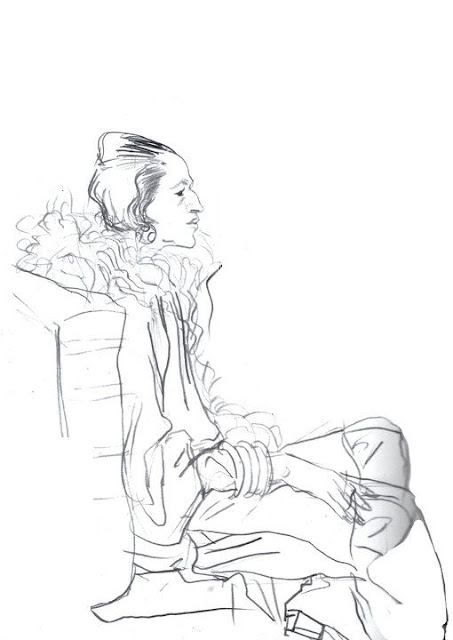Mel Odom, Portrait of Ms Vreeland, 1980s.
With the possible exception of Anna Piaggi, the appearance of no other fashion editor or matriarch in fashion has had quite the influence on illustrators and artists like the figure of Diana Vreeland. Former editor in chief of American Vogue, Ms Vreeland's symbolic profile, one that can be reduced to just a nose bump and cigarette holder is one so recognizable and so emblematic of an era that many continue to be inspired to transcribe her image to this day.
The results shown here by a significant roster of artists from past and present interestingly all portray Vreeland's iconic appearance consisting of black clothing, pale skin and red make-up, proving Vreeland's self-constructed image has equally immortalized itself alongside her leadership.
Mel Odom on the story behind his portrait:
"It was done in the 1980s as a thank you to Ms Vreeland for the giant signature she wrote in my copy of Allure. I did it overnight and ran it to her building the next day after I got the book. I did it so fast that years later when it was auctioned off with her other things I had forgotten even having done it. When the one-woman show about Ms Vreeland, "Full Gallop" was running in NYC I went to see it with friends. My drawing (actually a copy) was framed and hanging on the set of her apartment. I spoke with the stage manager who let me go on stage after the show for a closer look. He told me that if it was hanging on the set it had also been hanging in her home the same way, as the set was a precise copy of the real thing. I was thrilled!" Mel Odom
David Downton, Personal Work, 2013
"I think she appeals to artists so much because she was self-invented. Larger than life. In a sense she had already done the drawing. I would have loved to have met her..." David Downton
Richard Haines for What I Saw Today, 2011.

Richard Haines for What I Saw Today, June 2011.
Zoe Taylor, Too Much Night, Syntax Editions 3, 2010.
Diana Vreeland looks at a drawing with Cecil Beaton, 1965.
Jean Paul Goude, Lady Diana Vreeland, 2015.
Kenneth Paul Block, 1967.
Kenneth Paul Block, year unknown.
Mats Gustafson, 1982.
Antonio Lopez, year unknown.
Joe Eula, year unknown.
Richard Bernstein, Interview Magazine, December 1980.
Richard Ely, 1989.
Cecil Beaton, 1954.
Cecil Beaton
Diana Vreeland, The Modern Woman; The Bazaar Years 1936-1963. Rizzoli Publishing, 2015.
René Bouché, Date Unknown









































































